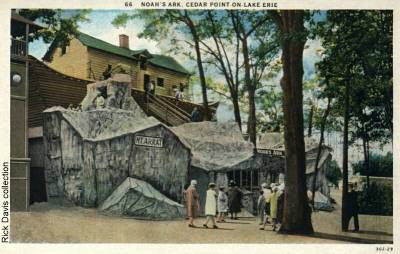 The original Noah’s Ark
is a familiar bible story that almost everyone knows. Noah was to build an ark capable of
carrying two of each animal (more in some cases). He was to then board the ark with his
family and animals, while it would rain for forty days and forty nights. It is said that
after the rains had stopped, the ark came to rest on Mt. Ararat. It is the popularity of
this story that led to one of the most duplicated funhouse style attractions ever. The original Noah’s Ark
is a familiar bible story that almost everyone knows. Noah was to build an ark capable of
carrying two of each animal (more in some cases). He was to then board the ark with his
family and animals, while it would rain for forty days and forty nights. It is said that
after the rains had stopped, the ark came to rest on Mt. Ararat. It is the popularity of
this story that led to one of the most duplicated funhouse style attractions ever.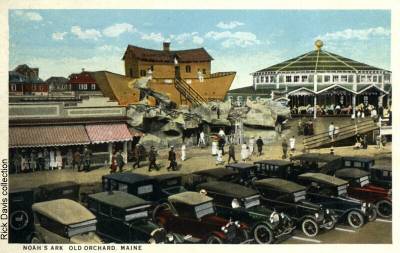 The first Noah’s Ark appeared at Venice Pier
(California) in 1919. The ride was designed and built by Leroy Ramond who sold the
manufacturing rights to William Dentzel the following year. After that, the ride was
duplicated many times by Dentzel’s Noah’s Ark Company at amusement parks
throughout the United States and other countries. In 1928, William Dentzel died and the
company changed it’s name to the American Amusement Construction Company. The
original ride burned in the 1940s and one by one all but three of the rides disappeared. The first Noah’s Ark appeared at Venice Pier
(California) in 1919. The ride was designed and built by Leroy Ramond who sold the
manufacturing rights to William Dentzel the following year. After that, the ride was
duplicated many times by Dentzel’s Noah’s Ark Company at amusement parks
throughout the United States and other countries. In 1928, William Dentzel died and the
company changed it’s name to the American Amusement Construction Company. The
original ride burned in the 1940s and one by one all but three of the rides disappeared.
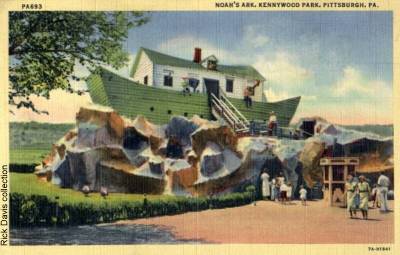 The only ride remaining in the North America is at Kennywood Park in
Pittsburgh, PA. They originally wanted to build an Ark in the 1920’s but the great
depression delayed their plans until 1935. Kennywood’s Ark was built by the
Philadelphia Toboggan Company (now Philadelphia Toboggan Coasters), who had acquired the
rights to build the Arks. The Kennywood Ark was the last one ever produced. It was
completely refurbished in 1969 with new scenes, animals and stunts. The famous whale
entrance was also added at that time along with a new, larger mountain. The 1996-97 season
saw another major refurbishment to assure that the Ark will last for another generation.
The only other two operating rides are in the United Kingdom at Blackpool Pleasure Beach
and Frontierland. The only ride remaining in the North America is at Kennywood Park in
Pittsburgh, PA. They originally wanted to build an Ark in the 1920’s but the great
depression delayed their plans until 1935. Kennywood’s Ark was built by the
Philadelphia Toboggan Company (now Philadelphia Toboggan Coasters), who had acquired the
rights to build the Arks. The Kennywood Ark was the last one ever produced. It was
completely refurbished in 1969 with new scenes, animals and stunts. The famous whale
entrance was also added at that time along with a new, larger mountain. The 1996-97 season
saw another major refurbishment to assure that the Ark will last for another generation.
The only other two operating rides are in the United Kingdom at Blackpool Pleasure Beach
and Frontierland.
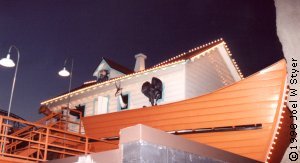 The ride is a wooden boat placed upon what appears to be a jagged
pile of rocks. This is to simulate its supposed resting-place on Mt. Ararat. The animals
gander out the windows, looking over those who enter. The walking pattern within the Ark
varied by installation. Some Ark’s were entered at the bottom level and others a ramp
or steps to the top. The current Kennywood Ark uses an elevator. The Ark is not one large
room but long winding passageways. At one point the passage would lead to another level.
The exit of the ride could have been a simple doorway or a slide from the upper level. A
number of "stunts" or ‘gags’ were used throughout the ride. The number
of stunts also varied by installation. Some were static such as the animals or Noah’s
family members sitting in a diorama. The ride is a wooden boat placed upon what appears to be a jagged
pile of rocks. This is to simulate its supposed resting-place on Mt. Ararat. The animals
gander out the windows, looking over those who enter. The walking pattern within the Ark
varied by installation. Some Ark’s were entered at the bottom level and others a ramp
or steps to the top. The current Kennywood Ark uses an elevator. The Ark is not one large
room but long winding passageways. At one point the passage would lead to another level.
The exit of the ride could have been a simple doorway or a slide from the upper level. A
number of "stunts" or ‘gags’ were used throughout the ride. The number
of stunts also varied by installation. Some were static such as the animals or Noah’s
family members sitting in a diorama.
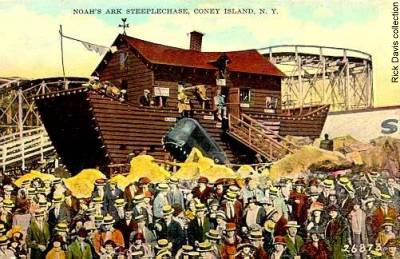 An operator triggered some gags when
unsuspecting guest gets close enough. This is the case with the blast of air that would
blow the skirts of women up into the air. Usually done in full view of the park patrons,
this was a common stunt in many funhouses. Crowds would gather just to watch. Another
popular stunt used was the shaker boards or barrels. These were vibrating boards (or
barrel tops) on the floor that caused a loss of balance. In the old days, you had to
transverse these in order to continue with the ride. In these modern litigious times, a
bypass is now provided for those who choose not to participate. An operator triggered some gags when
unsuspecting guest gets close enough. This is the case with the blast of air that would
blow the skirts of women up into the air. Usually done in full view of the park patrons,
this was a common stunt in many funhouses. Crowds would gather just to watch. Another
popular stunt used was the shaker boards or barrels. These were vibrating boards (or
barrel tops) on the floor that caused a loss of balance. In the old days, you had to
transverse these in order to continue with the ride. In these modern litigious times, a
bypass is now provided for those who choose not to participate.
Another impediment to walking through the ride is the balancing
walk. This is where you seemingly have to walk on small stones or narrow board to complete
your journey. It appears that there is a large drop with vicious critters waiting to
devour you if you should slip. And in the pit below you are the skeletal remains of those
who should have been more careful. Of course it is only your imagination that puts you in
danger, a clear piece of glass (now PlexiglasTM) prevents the catastrophe that
appears so real.
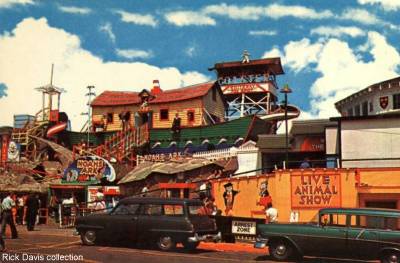 Between these highly active moments are a multitude of
dioramas and displays. In older days, there were more mechanical stunts than static
displays to provide thrills but many have disappeared due to safety concerns. Sound also
played an important part in the Arks. Whether it be the soothing sound of rain, thunder
and lightning or Noah himself barking at you to move, the sounds added one more dimension
to all that was happening. Small details also played an important part. Many of the
corridors use "forced perspective" Between these highly active moments are a multitude of
dioramas and displays. In older days, there were more mechanical stunts than static
displays to provide thrills but many have disappeared due to safety concerns. Sound also
played an important part in the Arks. Whether it be the soothing sound of rain, thunder
and lightning or Noah himself barking at you to move, the sounds added one more dimension
to all that was happening. Small details also played an important part. Many of the
corridors use "forced perspective"
1 to create the illusion that the pathway is longer than it
is or to give you the feeling that it will become too small to pass through. All the while
you experience these effects, the entire boat is slowly rocking back and forth just to
keep you a bit more off balance and reinforce the notion that you are indeed on a boat.
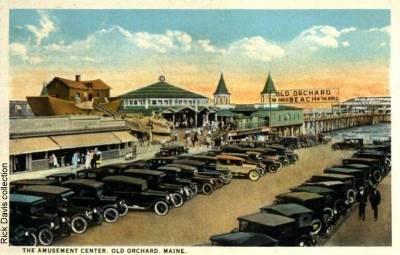 While much of this information is based on
Kennywood’s Ark, most of the stunts were common to many funhouse attractions. For the
1986 rebuilding, they made several unique additions. As you enter, no longer do you have
to walk up the steps but you must now take the elevator. This is no ordinary elevator but
the "elevator of doom". The effect is of an elevator plunging out of control.
Just before exiting the ride, you enter the flooding chamber. As you stand there, a quite
large amount of water is poured just inches away and gives the illusion that the room will
be flooded. While much of this information is based on
Kennywood’s Ark, most of the stunts were common to many funhouse attractions. For the
1986 rebuilding, they made several unique additions. As you enter, no longer do you have
to walk up the steps but you must now take the elevator. This is no ordinary elevator but
the "elevator of doom". The effect is of an elevator plunging out of control.
Just before exiting the ride, you enter the flooding chamber. As you stand there, a quite
large amount of water is poured just inches away and gives the illusion that the room will
be flooded.
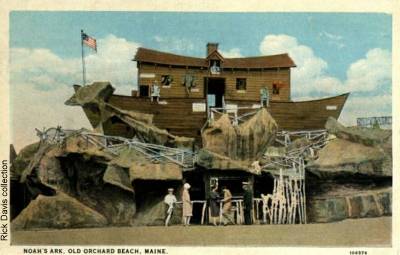 But there is more to Noah’s Ark than meets the eye.
There is the mechanism that rocks the boat as well as those for the other mechanical gags.
There also has to be ducts for electric, air ventilation and water throughout the ride.
These are ingeniously woven in between the pathways that you follow. The boat rocking
mechanism though is by far the largest. It consists of a large motor that drives a set of
gears. The gears drive a shaft, which pushes or pulls on wooden supports that are designed
for the rocking motion. The setup is quite ingenious and simple. But there is more to Noah’s Ark than meets the eye.
There is the mechanism that rocks the boat as well as those for the other mechanical gags.
There also has to be ducts for electric, air ventilation and water throughout the ride.
These are ingeniously woven in between the pathways that you follow. The boat rocking
mechanism though is by far the largest. It consists of a large motor that drives a set of
gears. The gears drive a shaft, which pushes or pulls on wooden supports that are designed
for the rocking motion. The setup is quite ingenious and simple.
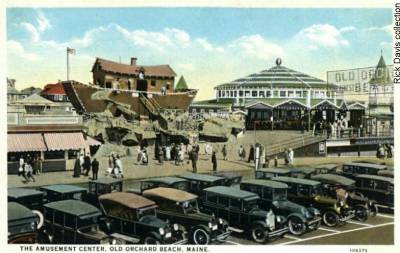 Upon your next visit to Kennywood or one of the two UK
parks, take the time to go back in time and ride the Noah’s Ark. It is bound to bring
a smile to your face. Upon your next visit to Kennywood or one of the two UK
parks, take the time to go back in time and ride the Noah’s Ark. It is bound to bring
a smile to your face.
|


 The original Noah’s Ark
is a familiar bible story that almost everyone knows. Noah was to build an ark capable of
carrying two of each animal (more in some cases). He was to then board the ark with his
family and animals, while it would rain for forty days and forty nights. It is said that
after the rains had stopped, the ark came to rest on Mt. Ararat. It is the popularity of
this story that led to one of the most duplicated funhouse style attractions ever.
The original Noah’s Ark
is a familiar bible story that almost everyone knows. Noah was to build an ark capable of
carrying two of each animal (more in some cases). He was to then board the ark with his
family and animals, while it would rain for forty days and forty nights. It is said that
after the rains had stopped, the ark came to rest on Mt. Ararat. It is the popularity of
this story that led to one of the most duplicated funhouse style attractions ever.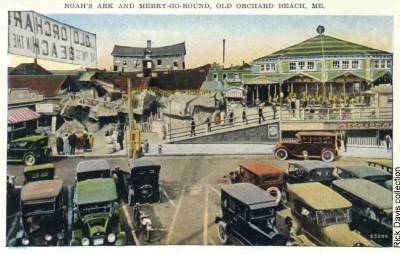
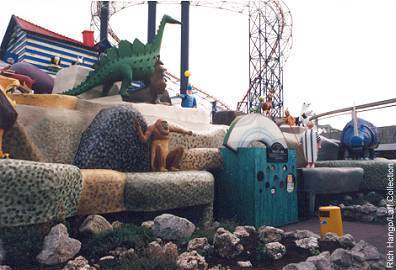
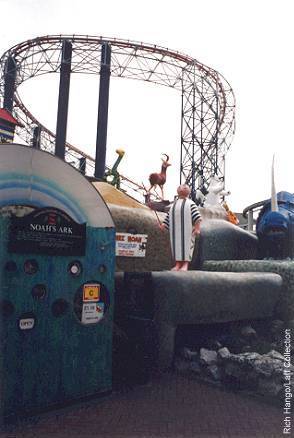 left and above: Photos of the Noah's Ark attraction at Blackpool
Pleasure Beach in the UK.
left and above: Photos of the Noah's Ark attraction at Blackpool
Pleasure Beach in the UK.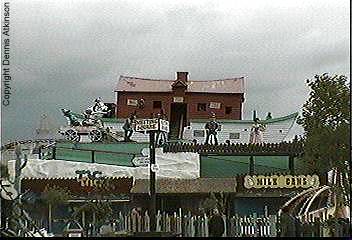 To the left is
the Noah's Ark at Frontierland in the UK. This and the Blackpool Ark above are the two
remaining Noah's Ark attractions in addition to Kennywood's. All three parksshould be
commended for keeping these rides.
To the left is
the Noah's Ark at Frontierland in the UK. This and the Blackpool Ark above are the two
remaining Noah's Ark attractions in addition to Kennywood's. All three parksshould be
commended for keeping these rides.